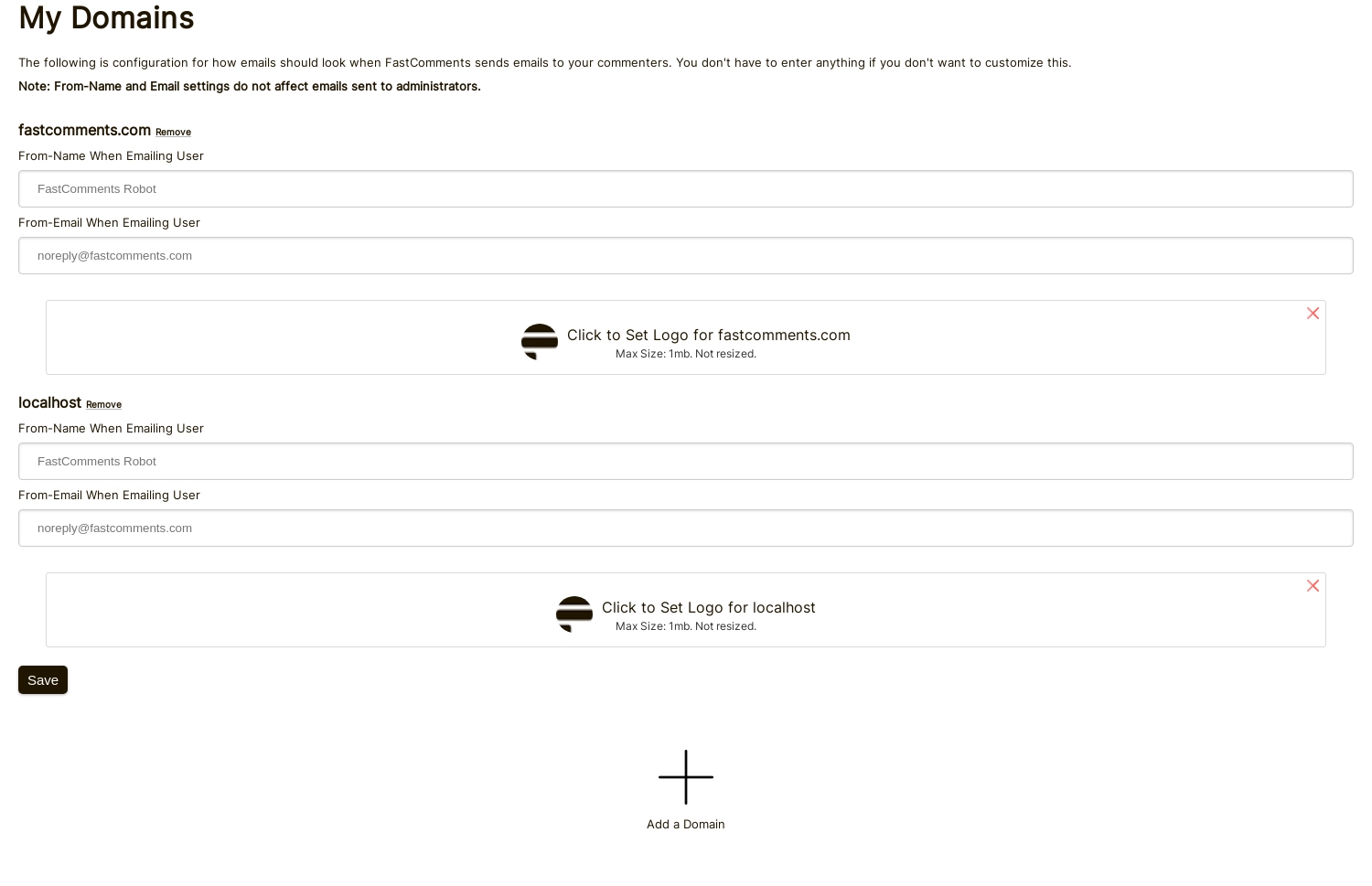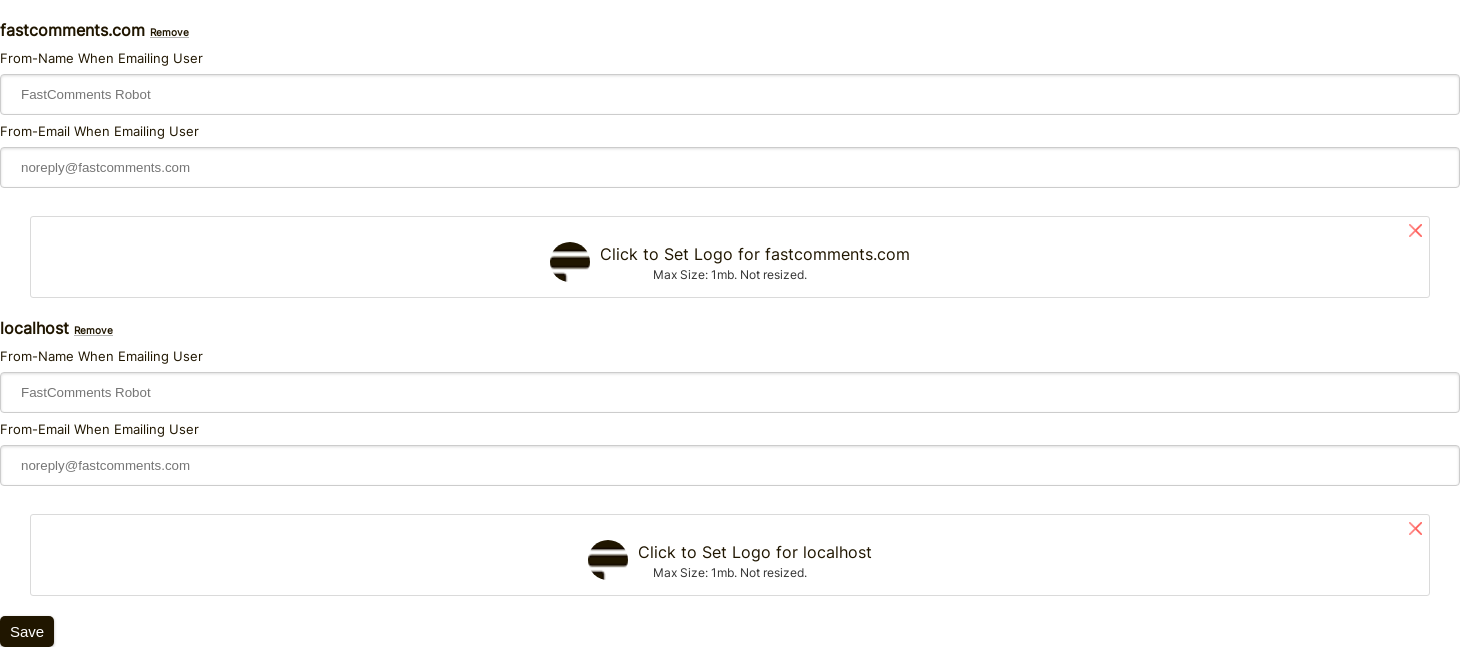
Getting Started
Per-Site Customization
Data & Search
Integration Notes
Multiple Sites
In this guide we'll cover having multiple sites, domains or subdomains, in the same FastComments account as well as some common use cases.
Initial Setup 
FastComments authenticates requests to your account to see that they are coming from your site. This is why we need to know which site, or sites, you want to install FastComments on.
FastComments supports authentication by means of domain, as well as subdomains.
Let's take the site https://example.com. In this case, "example.com" is the domain. example.com supports both example.com, and www.example.com. We'll call the "www" the "subdomain".
For Example:
- To allow only
blog.example.com:- Add
blog.example.comto your domains.
- Add
- To allow
www.example.com,somesite.example.com, andexample.com:- Add
example.comto your domains. - This is billed as having one domain associated with your account.
- Add
- You can now add wildcard subdomains, for example *myname.vercel.app.
- This is billed as having one domain associated with your account.
If you were using a blogging platform, and you were given a subdomain, you would want
to add the full domain including the subdomain to your account, for example: cats.blogger.com.
We can add domains to our account by visiting the My Domains page and clicking Add a Domain at the bottom:
During the trial period, domains are automatically added to your account when requests come from said domains. However, after this time they must be added explicitly for security. You should receive an email when this automated behavior occurs.
You do not have to add localhost for local development - it is allowed by default.
Via The API
Domains can also be added and configured via the DomainConfigs API.
Limits and Pricing 
To found out the limit for the number of domains in your account, visit the Billing Page.
Pricing
The pricing varies based on package:
- FastComments for Creators
- Included in package pricing. Limit of three sites.
- FastComments Flex
- First site is included. Each additional site is $10/mo.
- FastComments Pro
- A large number of sites (can vary based on agreement) is included in package pricing.
Traffic Limits & Domains
In the example where you are on a tier with five million monthly page loads with five domains added to your account, and each domain ends up with one million-page loads, you will have met your monthly quota.
To summarize, traffic limitations are per-account, not per-domain.
Note that we do offer custom packages for different size sites, simply reach out to support.
From Name, Email, and Logo 
Sometimes FastComments has to email your users, especially if you are not using Secure SSO.
Examples of this includes verifying their account or activity when commenting for the first time. FastComments will also send them notifications for replies to their comments.
When FastComments emails your users, we will use a default From Name and Email of FastComments Robot and noreply@fastcomments.com.
We'll also use our own logo in the footer of these emails.
If you have FastComments Flex or Pro, this all can be customized on a per-domain basis via the "My Domains page":
When customizing the logo shown in emails, ensure that the size you are uploading is the same size that you want to show in the footer of the email.
When Customizing The From Domain
If you customize the From Domain, Email providers and clients need to know that FastComments is authorized to send emails on your behalf. Otherwise,
defining the From Domain and not following the below steps likely will result in emails going to spam.
1. Setup SPF
To allow FastComments to securely send email as your domain, ensure you add an SPF record that allows us to do so.
Ensure there are SPF records to allow mail.fastcomments.com and sib.fastcomments.com to send mail as your domain.
Some more information on how to do this is here: https://mailtrap.io/blog/multiple-spf-records/
2. Setup DKIM
In addition to SPF, you should set up DKIM. Once your DNS configuration is ready, you can click "Show Advanced" in the domain configurations page to show the DKIM settings per-domain.
You can also invoke the API to set DKIM configuration.
Unsubscribe Links
When using SSO, the unsubscribe features used in emails and notifications can be customized via the DomainConfigs API.
Domain From Name/Email Not Working 
If you see in testing your from name/email/logo settings specified above are not working, this could be because these settings only apply to emails that can be tied to a domain. This means these settings do not apply to most admin emails, however when commenters get email notifications it will use your settings.
Tenant Per Environment 
It is common to have a sub tenant per test or dev environment with FastComments. Each tenant would have its own configuration, data, and API keys. Configuration, data, and users cannot be shared across tenants. Everything is isolated. However, super admins of the parent tenant can impersonate users in child tenants.
There are two approaches:
- The main tenant is for production, and sub-tenants are for test environments.
- The main tenant is simply for billing, and each sub-tenant is for prod, test, and so on.
The first is generally easier for users to reason about, but this may depend on your organization.
Tenants can be created here if you have the package. This is also where super admins would impersonate users. Tenants can also be created via the API for more custom/automated setups.
No matter the approach taken, you'll have to add the moderators and users that want to see production data in the "prod" tenant. So for example if you want to go with option B and have the parent tenant for billing, and have a sub tenant for "prod", you'll want to add the tenant, switch to the new tenant, and add your admin and moderator users for the sub-tenant.
Finally, to clarify, the Moderate Comments page will be empty with option B for the parent tenant.
Customizations 
The comment widget can be customized differently for each site.
On the widget customization page, you'll find a dropdown labeled "domain". Selecting All in this field will apply the rule to all
sites on your account, you can enter a specific domain which will restrict the settings or custom CSS you wish to apply to only that domain.
This allows you to have FastComments look or function completely different for each site.
For one site might use bold text and allow anonymous commenting, and another site might have different styling and require the user to leave their email when they comment.
Comment Moderation 
The Moderate Comments page combines the comments across all of your sites.
In order to find the comments for a specific site, simply search for the domain with quotes, for example: "blog.fastcomments.com".
Sharing Comments Across Domains 
Comments themselves are not tied to a particular domain.
They are tied to your account, and the urlId provided.
This means that we can render the same comment thread on two separate sites with the same FastComments account by simply passing in the same value for urlId in
the widget configuration.
In this scenario, comments posted on page A would immediately appear on page B, and vice-versa. Live commenting also works as expected.
With WordPress 
You can use the same FastComments account with multiple WordPress deployments. When you set up the plugin a separate integration token is added each time. You can view your active integrations here.
You can also use the same FastComments account with a WordPress installation that spans multiple domains and has the same content on those domains.
In Conclusion
You've reached the end of the Multiple Sites documentation. Let us know what further comments or questions you have below - you may also reach out to us via the Support Page.
If you feel like this documentation is missing something please ask as others will benefit.



